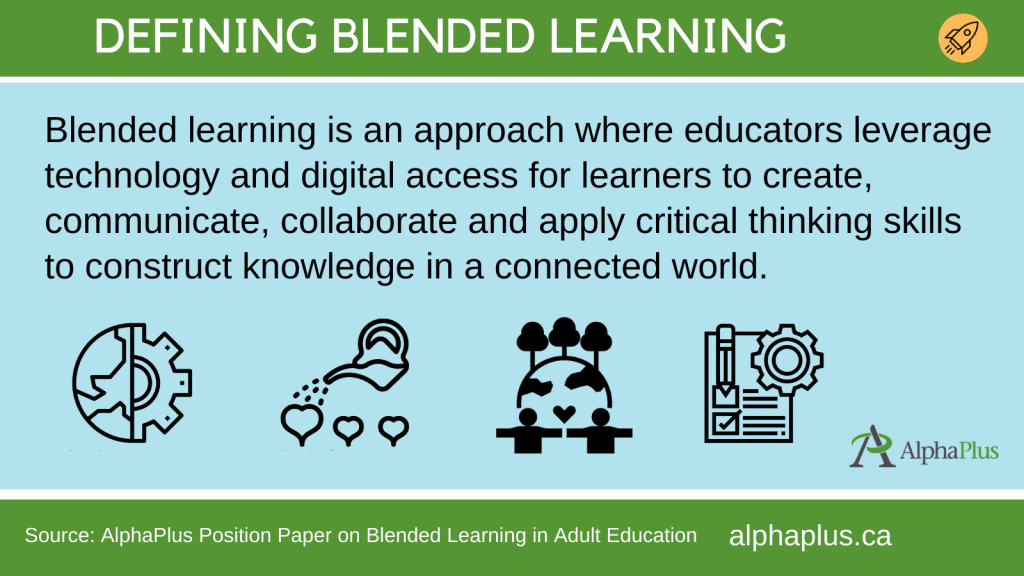Defining Blended Learning in Adult Education

Blended learning is widely seen as a combination of face-to-face in classroom and technology-mediated learning using devices such as computers, smartphones, tablets and other mobile devices with an internet connection.[1] These devices may be provided by programs, or learners may be free to bring their own device.
Our position is that blended learning in adult education is not only about the use of tools and resources. Instead, it is a way to think about program and curriculum development, including learning design and delivery.
Using digital technology in a blended approach is not just learning how to operate digital devices and navigate the internet. These are important skills that enable participation in a blended learning program but, by themselves, are not necessarily blended learning. A blended learning approach is one that enhances and extends the application of adult learning principles to meet the changing needs of people learning, working and engaging in 21st century life.
The term blended learning was first used in relation to higher education in the late 1990s, a time of rapid increase of computer and internet use.[2] It was not long after that adult education practitioners and researchers were exploring the relevancy of blended learning in adult education. Today, many learners are already online via their mobile devices. Adult education programs no longer view digital technology as supplemental to paper-based learning, and many educators have combined paper-based resources with digital technology in their teaching practices for quite some time.
Based on AlphaPlus’s experience in the field, most research and discourse about blended learning has been focused on changing traditional curriculum-based, course-based and group classroom-based educational experiences. This is not the way adult education delivery is done by all the adult education providers that AlphaPlus supports. Instead of relying on a fixed curriculum and course-based delivery for groups of learners, most adult education programs support learners one on one in achieving individualized educational experiences. This involves using paper- and digital technology-based resources and tools inside and outside the classroom so that learning can occur at times, at locations and in ways that best suit learners’ needs and intentions in building their literacy skills and knowledge.
The discussion about blended learning in adult education needs to extend to the realities of adult basic education programs that operate in an individualized educational context as well as those that are course-based and use a fixed curriculum.
Educators develop blended learning experiences by collaborating with learners to ensure that learning outcomes are aligned with real-world contexts and to enhance learners’ capability to be self-reliant.[3] This approach also helps people to become self-directed in learning. Many adult learners step in and step out of programs over time. Self-directed learners can continue learning within and outside of formal learning institutions. Blended learning can enhance the ability of educators to meet the needs of adult learners and work towards their goals as they become lifelong learners and balance learning with other demands in adult lives.
Blended learning is often defined as any combination of face-to-face and online instruction,[4] but not all combinations are blended learning.
For example, in some adult education programs, educators support learners who are participating in online independent study courses that are designed and delivered by external organizations, without input or control over the content or delivery. While this can be an effective way to create a hybrid of learning environments that meets the need of learners who want to learn online and build their capability to learn remotely, it cannot be said to adhere to the principles of blended learning because the educators and learners are not actively engaged in creating and transforming the curriculum.
To properly articulate desired outcomes and implications for adult education providers, intermediary organizations and broader networks, and policy and program planning, an educational definition of blended learning is needed rather than an operational definition. Our definition of blended learning in adult education is as follows:
Blended learning is an approach where educators leverage technology and digital access for learners to create, communicate, collaborate and apply critical thinking skills to construct knowledge in a connected world.
The Pressures on Adult Education Providers
[1] Graham, 2006; Palalas, 2019.
[2] Friesen, 2012.
[3] Hase & Kenyon, 2001; 2013; Ryan & Deci, 2000.
[4] Graham, 2006; Kennel & Moriarty, 2014; Palalas, 2019.


Feedback/Errata